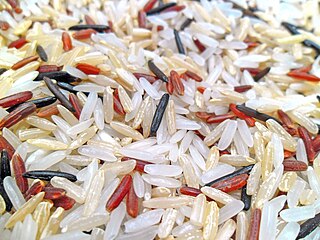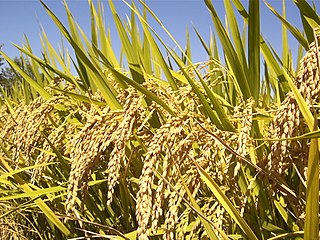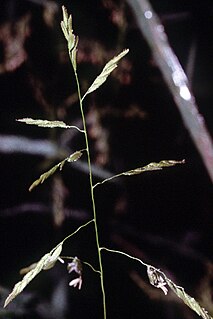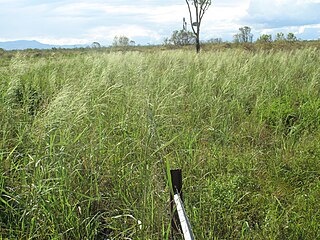
Rice is the seed of the grass species Oryza sativa or Oryza glaberrima. As a cereal grain, it is the most widely consumed staple food for a large part of the world's human population, especially in Asia. It is the agricultural commodity with the third-highest worldwide production, after sugarcane and maize.

Wild rice are four species of grasses forming the genus Zizania, and the grain that can be harvested from them. The grain was historically gathered and eaten in North America, India and China. While now a delicacy in North America, the grain is eaten less in China, where the plant's stem is used as a vegetable.

Oryza sativa, commonly known as Asian rice, is the plant species most commonly referred to in English as rice. Oryza sativa is a grass with a genome consisting of 430Mb across 12 chromosomes. It is renowned for being easy to genetically modify, and is a model organism for cereal biology.
Indica is classical Greek and Latin for "of India". It may refer to:

Wehani rice is a variety of aromatic brown rice developed in the late 20th century by Lundberg Family Farms of Richvale, California. It is a registered trademark of Lundberg Family Farms, the only company that grows it, and is named for brothers Wendell, Eldon, Homer, Albert, and Harlan Lundberg.

The Pangil River, also known as the Bambang Hari River, is a river system that runs through Pangil, Laguna in the Philippines. It is one of 21 River tributaries of Laguna de Bay and is regularly monitored by the Laguna Lake Development Authority(LLDA) through one of its 15 river monitoring stations.
Oryza longistaminata is a perennial species of grass from the same genus as cultivated rice. It is native to most of sub-Saharan Africa and Madagascar. It has been introduced into the United States, where it is often regarded as a (noxious) weed. Its common names are longstamen rice and red rice.

Leersia oryzoides is a species of grass known by the common name rice cutgrass or just cut-grass. It is a widespread grass native to Europe, Asia, and North America and present in many other regions, such as Australia, as an introduced species. This is a rhizomatous perennial grass growing to a maximum height between 1 and 1.5 meters. The leaves are up to about 28 centimeters long and have very rough, minutely toothed edges. The inflorescence is a loose, open array of wavy, hairlike branches bearing rows of spikelets. Each spikelet is a flat fruit with a rough, bristly lemma without an awn, and no glumes. Some of the spikelet branches develop within the sheaths of the leaves and are cleistogamous. This grass is sometimes used for erosion control and restoring wetlands.

Oryza glaberrima, commonly known as African rice, is one of the two domesticated rice species. It was first domesticated and grown in West Africa, and was brought to the Americas by enslaved West African rice farmers. It is now largely a sustenance crop, rarely sold in markets even in West Africa.

Japonica rice, sometimes called sinica rice, is one of the two major domestic varieties of Asian rice. Japonica rice is extensively cultivated and consumed in China, Japan, Korea, and Taiwan, whereas in most other regions Indica rice is the dominant type of rice.
Porteresia coarctata is a species of grass in the Poaceae family, native to India, Sri Lanka, Bangladesh, and Myanmar.

Oryzeae is a tribe of flowering plants in the true grass family, Poaceae. It contains 12 genera, including both cultivated rice (Oryza) and wild rice (Zizania).

Perennial rice are varieties of long-lived rice that are capable of regrowing season after season without reseeding; they are being developed by plant geneticists at several institutions. Although these varieties are genetically distinct and will be adapted for different climates and cropping systems, their lifespan is so different from other kinds of rice that they are collectively called perennial rice. Perennial rice—like many other perennial plants—can spread by horizontal stems below or just above the surface of the soil but they also reproduce sexually by producing flowers, pollen and seeds. As with any other grain crop, it is the seeds that are harvested and eaten by humans.
Oryza brachyantha is a grass in the rice genus Oryza, distantly related to cultivated rice O. sativa, and native to tropical Africa. It is an annual grass that grows as a tuft.
Oryza punctata is a grass in the rice genus Oryza, also known as red rice, related to cultivated rice O. sativa, and native to tropical Africa, southern Africa, and Madagascar. It is a weed that grows in rice fields.

Oryza australiensis is a wild rice species native to northern Australia. It is a perennial plant that uses the C3 photosynthesis pathway.
Amazon wild rice refers to either of the two native (endemic) species of rice (Oryza) found in the Amazon region of South America and adjacent tropical areas, Oryza glumaepatula and Oryza latifolia. It also can refer to the cultivated form Oryza sp. which was domesticated from one or both of the wild forms some 4,000 years ago by the indigenous people of the Amazon region.












